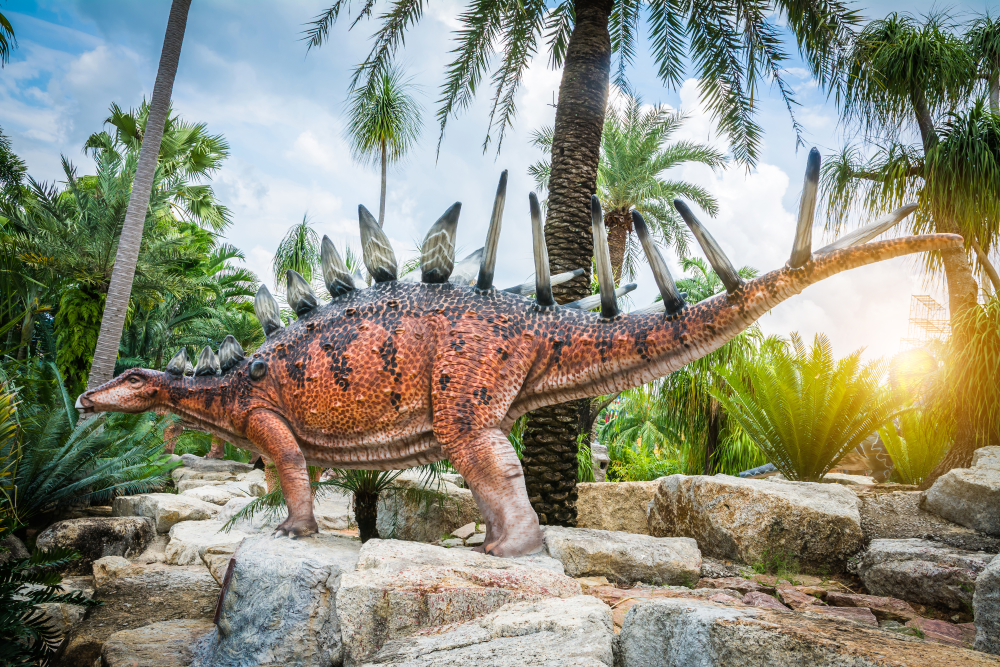Researcher are forever finding and naming new-to-science species of dinosaurs, but it feels like we don’t speak as much about where new dinosaurs came from in the most literal sense. That is, when two dinosaurs wanted to make baby dinosaurs, how did they do it?
Dinosaur sex is something that science writer and palaeontologist Riley Black has also questioned in the course of her career: the mechanics, the anatomy, and the fossil evidence that might go with it all. We spoke to Black about what the science so far has to say about how dinosaurs had sex, and which animals alive today might provide some clues.
How can we study dinosaur sex?
Until we dig up a pair of preserved dinosaurs that were committed to the fossil record mid-mating, we have to get a bit creative when looking for clues about how dinosaurs had sex. We actually have found examples of creatures like turtles and prehistoric sharks mid-copulation, but never for non-avian dinosaurs, says Black.
Instead, one genre of evidence we can look to is trace fossils – that’s things like footprints. The act of mating itself might not be carved into the environment, but any courtship display that went with it just might be, and we actually already have a pretty solid idea about this behavior in dinosaurs.
“So, most of this conversation is hypotheticals, [but] this is one case where we can say yes, we are certain that at least some dinosaurs had some kind of courtship ritual,” said Black. “For alligators and crocs – it’s absolutely beautiful when you see it – the males will lay in the water, they will rumble and make these deep bellowing calls, and the water will dance on their back.”
It basically looks like Godzilla chickens must have lived here
Riley Black
We can’t yet know if dinosaurs did exactly that, but even when we look to the the birds (dinosaurs’ other close relatives), we see that courtship displays are widespread. Some birds dance to attract a mate, while others scrape substrate as part of their courtship display, and there are ancient trace fossils that appear to show a similar behavior in birds’ much bigger ancestors.
“It basically looks like Godzilla chickens must have lived here and were all in their own spot, scratching at the ground with these three-toed feet,” said Black. “These were made by theropod dinosaurs. These were made by dinosaurs that were probably something like Allosaurus, even though they’re a bit later in time, but that’s a decent image of what this animal would probably look like. So, we have a sense that, at least for some of these dinosaur species, they were coming together in groups and they were showing off and advertising themselves as part of courtship.”
Dinosaur genitalia
There’s another form of fossil evidence that has taught us about dinosaur sex: soft tissue fossils of their genitalia. Or, to be specific, really just one so far: a remarkable fossil Psittacosaurus (what Black describes as “sort of a reptilian parrot”).
Remarkably preserved with soft tissues intact, it exhibits a cloaca: a three-in-one trait seen in animals alive today (including birds, reptiles, amphibians, some fish, and monotremes) that facilitates the passage of digestive, reproductive, and urinary matter. It had been hypothesized for a while that dinosaurs might have had cloacas given we see them in crocodiles and alligators, and this incredibly rare fossil backed the theory.
Looking to closely-related animals that are alive today for clues like this is what’s known as phylogenetic bracketing, and it can be a good way to try and fill in the blanks for behaviors that are rarely captured in the fossil record. There’s no single modern analog that can act as a good representative for all of Dinosauria, but what we see in birds – and particularly crocodilians – is a good starting point.
The way the alligators and crocs are set up[…] that’s our best guide for what an animal like Stegosaurus or Allosaurus might have had
Riley Black
“It’s almost certain that non-avian dinosaurs had the same kind of anatomy, that any genitals would be held behind that cloaca, and [the Psittacosarus] is confirmation [of that],” said Black. “Unfortunately, there’s not really much preserved beyond it. We’re just getting the outside view, but at least it’s something that gives us some sort of expectation about, if we are to find additional soft tissue anatomy, what that’s going to look like.”
How do we think dinosaurs had sex?
We know birds are dinosaurs, but when it comes to how they have sex, they may not be the best models for all dinosaurs as some of their traits and behaviors evolved after Chicxulub killed them all off. That may include one of their key modes of mating (though bird sex can change dramatically depending on whether or not the species in question has a penis, or complex vaginal layout).
“We know that many modern birds, especially songbirds, are able to pass sperm through a ‘cloacal kiss’, and that’s something that does not involve any kind of, what we would call an ‘intermittent organ,’ in the jargon,” said Black. “That’s what we call a derived feature. Something that evolved over the evolution of birds likely sometime in the Cenozoic, after the mass extinction that ended the Cretaceous.”

Water would probably have made dinosaur sex a whole lot easier.
Image credit: Alena A / Shutterstock.com
“So, for looking at sort of models for non-avian dinosaur anatomy, the way the alligators and crocs are set up, as well as some of what we might think of the more archaic birds (the birds are kind of at the base of the family tree), that’s our best guide for what an animal like Stegosaurus or Allosaurus might have had.”
There’s probably no non-awkward way for those non-avian dinosaurs to mate.
Riley Black
It’s expected dinosaur sex probably involved some form of penetrative sex, with nothing appearing out of the cloaca until mating was about to happen. As for what came next, looking to crocs and alligators is tricky because they enjoy a floaty environment when mating in the water, something our poor terrestrial dinosaurs and their great, weighty tails didn’t have the luxury of. Add to that the fact that size wasn’t the only obstacle, and you can start to appreciate quite how difficult mating must have been.
Dinosaur sex: who had it the hardest?
“There’s a particular stegosaur that I don’t understand how these animals managed to reproduce,” said Black when asked which species she finds the most puzzling to piece together. “Its name is Kentrosaurus, it comes from Tanzania, and it is a relative of our more famous Stegosaurus in Western US.”
“Rather than [having] plates all the way down its back, the plates go from basically the base of the neck to the shoulders, and then they turn into spikes running down its back all the way to the tip of its tail, and with the tail, moving it out of the way is so crucial[for mating].”

All aboard.
Image credit: YuRi Photolife / Shutterstock.com
“Unless both of these dinosaurs are kind of laying on the ground and going belly to belly, or the male is kind of laying sideways over the female, perhaps, or something like that? It would have had required a bit of creativity in terms of the positioning. So, in terms of what dinosaur sex positions were, I feel like, specifically, the more spiky Stegosaurs would have needed to be the most creative out of all of them.”
It seems, when it comes to working out the mechanics of dinosaur sex positions, there’s only one thing we can say for certain.
“There’s probably no non-awkward way for those non-avian dinosaurs to mate.”
Want to find out more? Catch the full interview with Riley Black on IFLScience’s podcast, The Big Questions. This episode was part of series 2, and we have more episodes on the way. Catch all our existing episodes here, or check out IFLScience’s other podcasts, Break It Down, and We Have Questions.
Source Link: How Did Dinosaurs Have Sex? A Guide To Studying Extinct Love Lives